Shipboard Scientific Party
Physical property evolution in sedimentary sequences, including accretionary prisms, cannot be comprehensively evaluated with recovered cores and must be studied in situ. Elastic rebound and microcracking of coherent sedimentary samples degrade laboratory physical property measurements. Fault gouge and other incoherent lithologies are either not recovered or cannot be measured after recovery. Transient properties (e.g., excess pore pressures) must be measured in situ (Fisher et al., 1996; Screaton et al., in press). Logging while drilling (LWD) is the best available tool for measuring physical properties of the typically underconsolidated prism sediments; LWD results can be used as input to time transient models of prism evolution.
Large strains at subduction zones accelerate the rate of change in the physical properties of sedimentary sequences that are accumulating and deforming there. Accretionary prisms allow us to study these changes because deformational features are shallowly buried and shallowly dipping, and therefore can be cored and imaged seismically. Studies of fault geology, sedimentary consolidation, and seismic imaging at subduction zones aid in understanding hydrocarbon migration, groundwater flow, and seismicity in other less active sedimentary environments. Logging while drilling was conducted in a transect across the toe of the northern Barbados accretionary prism (Fig.1) to better understand the interrelationships of deformation, fluid flow, seismic imaging, and changes in physical properties
(Figures, 2A, 2B, 3).
Tectonic Setting of the Northern Barbados Accretionary Prism The northern Barbados accretionary prism is the leading edge of the Caribbean Plate that is being underthrust by Atlantic Ocean floor at rates estimated between 20 and 40 km/m.y. (e.g., Dorel, 1981). On the west, the Lesser Antilles defines the volcanic arc, whereas east of the arc the island of Barbados is an outcrop of the forearc accretionary prism. Frontal structures south of the Tiburon Rise include long wavelength folds, widely spaced ramping thrust faults, and extensive décollement reflections (e.g., Bangs and Westbrook, 1991; Westbrook and Smith, 1983). North of the Tiburon Rise, trench sediment thickness is much thinner, and prism thrusts are more closely spaced (Biju-Duval et al., 1982; Westbrook et al., 1984). North of the Tiburon Rise, the Barbados accretionary prism reaches at least 10 km thick and 120 km wide in addition to a 50-km-wide forearc basin to the west (Bangs et al., 1990; Westbrook et al., 1988). Thus, the accretionary prism forms a wide low-taper wedge (Figs. 2A, 2B, 3).
Deep Sea Drilling Project (DSDP) Leg 78A and Ocean Drilling Program (ODP) Legs 110, 156, and 171A all focused on the northern flank of the Tiburon Rise. Here the décollement is relatively shallow, and the dominantly hemipelagic/pelagic sedimentary section offers good drilling conditions and good biostratigraphic resolution. In this area, previous drilling documented numerous biostratigraphically defined faults of mostly thrust displacement (Brown and Behrmann, 1990). The décollement zone becomes better defined in a landward direction and is a shear zone up to 40 m thick at Sites 671/948 (Mascle, Moore, Taylor, et al., 1988; Shipley, Ogawa, Blum, et al., 1995). Anomalies in pore-water chemistry (Gieskes et al., 1990; Kastner, in press) and temperature (Fisher and Hounslow, 1990) indicate focused fluid flow along fault zones and in sand layers. Models simulating this fluid expulsion from the prism suggest that the flow is transient (Bekins et al., 1995). The faults are characterized by suprahydrostatic, and locally near lithostatic, fluid pressures (Brückmann et al., in press; Labaume and Kastner, in press; Screaton et al., in press; Zwart et al., in press).
Logging While Drilling
LWD is the most effective tool for measurement of physical properties in poorly consolidated sediments where standard wireline systems previously acquired either no data or poor quality data. LWD provides measurements from the seafloor to the bottom of the deepest level of bottom-hole assembly penetration. It acquires a continuous log of physical properties directly above the drill bit where hole conditions are optimal for logging, and it measures properties of the formation minutes after cutting the hole, thereby closely approximating in situ conditions. A simplified configuration of LWD during Leg 171A are shown in Figures 4, 4A and 4B.
 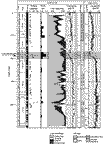  |
| Figure 4, 4A, 4B. A simplified configuration of LWD during Leg 171A. |
Objectives of the Logging Program
1. Overall Prism Consolidation.
Porosity distribution is the foundation for a variety of studies of the large-scale, long-term fluid budget of accretionary prisms. We can use logs to determine a continuous record of density and porosity as a function of depth as was done at Sites 947 and 948 during Leg 156. Between-site variation in the porosity-depth relationship provides an estimate of the amount of fluid expulsion (and therefore volumetric strain). Unfortunately in accretionary prisms, these measurements of volume change are usually impossible with standard logs, as they frequently fail due to the typically unstable hole conditions. Even under ideal conditions wireline logs do not obtain data from the top 60-120 m (because the drill pipe extends below the seafloor) nor the bottom 60-120 m of the hole (because of fill). The shallowest 100 m is of particular interest in volumetric studies because this is where porosity reduction is the greatest. Only LWD can obtain reliable porosity logs from the entire depth range, including the critical top 100 m.
2. Correlation of Physical Properties of Faults with Displacement and Fluid Flow.
There are several key questions that we wish to answer. Do faults collapse and strain harden with displacement (e.g., Karig, 1986)? Does active fluid flow retard this process and are collapsed faults inactive with respect to fluid flow (e.g., Brown et al., 1994)? Are hydrofractures as observed in the Barbados décollement common elsewhere? Can faults act as hydrologic conduits with variable and transient properties, as required by the models of Bekins et al. (1995)?
3. Consolidation State of Sediments in and Around Faults.
At Site 948, high quality density measurements demonstrated underconsolidation around faults, indicating the faults had recently loaded subjacent sediments. Consolidation state can also be interpreted in terms of effective stress and fluid pressure. Clearly the consolidation varies around faults and needs to be defined to develop a tectono-hydrologic model of the fluid expulsion system.
4. Physical Characteristics of Negative Polarity Seismic Reflections From Fault Zones.
Seismic reflections are created by changes in physical properties that can be measured in boreholes. In principle the seismic data provide a proxy for changes in physical properties on a tens of meters scale. Models reproduce the polarity and shape of seismic waveforms from the décollement zone beneath accretionary prisms (Bangs and Westbrook, 1991; Moore and Shipley, 1993). Accordingly, negative polarity reflections are interpreted as either due to overthrusting of higher over lower impedance sediment (Shipley et al., 1990) or due to the reduction of fault zone impedance through dilation (Bangs and Westbrook, 1991; Shipley et al., 1994; Bangs et al., 1996). The modeling, however, is incomplete without documenting the in situ physical properties across fault zones in areas with high quality 3-D seismic data.
RESULTS
Site 1044
Site 1044 lies on the northern flank of the Tiburon Rise 6 km east of the Barbados accretionary prism frontal thrust at ODP Site 672 (Figs. 2A, 2B, 3). Site 672 was drilled as an undeformed reference locality to gauge changes in the sedimentary section caused by accretion or underthrusting observed at other DSDP and ODP sites to the west. Surprisingly, the structural and geochemical anomalies at the projected stratigraphic level of the décollement showed that the section at Site 672 is disturbed by the encroaching accretionary prism. LWD at Site 1044 and data from Site 672 provide valuable baseline information on the nature of the incoming sedimentary section and set new limits on possible extent of proto-décollement deformation.
Site 672 provides a wealth of information for correlation to the Site 1044 LWD data. Cores at DSDP Site 543, located 18 km north on the oceanic plate, constrain the nature of the lower Eocene to Cretaceous part of the section not penetrated at Site 672. The sedimentary section is about 650 m thick beneath Site 672 and overlies oceanic crust of probable Cretaceous age. The uppermost Pleistocene to lower Miocene hemipelagic unit extends to about 200 mbsf and is equivalent to the section incorporated into the accretionary prism. This upper 200 m section correlates to seismic Unit 1, which displays moderately continuous reflectors and is underlain by the proto-décollement. The proto-décollement shows no deformation at the resolution of the seismic data; sediments below this are underthrust. The underthrust upper Oligocene to middle Eocene units consist of alternating muddy and calcareous lithologies with terrigenous sandstone and siltstone interbeds. Lower middle Eocene to Cretaceous rocks are siliceous, calcareous, and clay-rich pelagic deposits overlying pillow basalt.
The principal questions addressed at Site 1044 are: (1) What is the log signature of the proto décollement? Does this deformation zone include any indicators of hydrofractures, such as observed at Site 948? (2) What are the overall physical properties of the incoming section, especially porosity? Equivalents of this sequence are the sources of fluids being expulsed from the accretionary prism and underthrust sequence. (3) How do the observed physical properties determined from LWD account for the seismic reflection signature of this well-imaged incoming sedimentary section?
Site 1044 penetrated through 685 m of sediment to the basaltic basement of the North American Plate 6 km east of the frontal thrust of the northern Barbados accretionary prism. LWD acquired spectral gamma-ray, resistivity, density, caliper, photoelectric effect, and neutron porosity logs in this hole (Fig. 5A, 5B). All logs are of good quality except for neutron porosity. The high quality log data results from the in-gauge hole immediately behind the bit that the LWD tools sense. Ninety nine percent of the hole had differential caliper measurement of less than 1 in and 94% had less than 0.5 in. The density log mimics both the character and values of density measurements made from cores, further indicating log reliability.
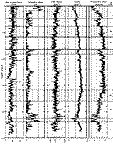 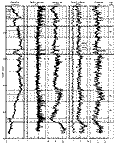 |
| Figure 5 (A, B) Summary of LWD data from Site 1044 compared to core data from Site 672. Shaded bar across diagram shows the proto-décollement zone. |
Both traditional visual and multivariate statistical analyses of the logs define six log units, which account for the majority of the lithologic variations observed in the cores. This profile of log properties specifies the nature of the incoming sedimentary section and correlates well with Site 672 and 3-D seismic survey data. This core-log-seismic data suite provides an unparalleled reference fanalysis of accretionary prism evolution to the west.
A decrease in density, resistivity, and gamma-ray logs from 169 to 189 mbsf defines log Unit 2, which correlates well with a structurally defined proto-décollement. Both logs and incompletely recovered cores recognize this low density unit, but logs better define its discrete boundaries and explicitly correlate it to a radiolarian mudstone interval at Site 672. A stratigraphically correlative mudstone interval always characterizes the décollement zone beneath the accretionary prism. Adjacent consolidation tests suggest high fluid pressures in this low density zone that would favor deformation there. The logs show no evidence in the proto-décollement for extreme fluid pressures, which might be seen as hydrofractures, and the geochemical evidence for fluid flow is equivocal here. The synthetic seismogram based on log results shows that this low density interval would have a reflection similar to that seen beneath much of the accretionary prism. Thus, incipient structures, physical properties, stratigraphic correlation, and seismic character all confirm that log Unit 2 is the proto-décollement.
Significant spikes in caliper, bulk density, resistivity and photoelectric effect plus a decrease in gamma-ray and an increase in resistivity values define log Unit 4 from 330 to 470 mbsf. This unit correlates with cyclically bedded sediments with high concentrations of sand and carbonate at Site 672. Anomalies in pore-fluid geochemistry suggest fluid flow in this unit. Lithologic properties derived from the logs indicate sand layers that could act as fluid conduits. A synthetic seismogram generated from the logs correlated through the 3-D seismic survey shows that this unit extends beneath the accretionary prism, where the fluids could be sourced.
Site 1045
Site 1045, located 2.7 km west of the frontal thrust, was drilled through the décollement zone of the northern Barbados accretionary prism (Figs. 2A, 2B, 3). This is the first penetration of a high amplitude negative polarity reflection of the Barbados décollement. This reflection might indicate high fluid pressures and perhaps physical dilation and hydrofractures. Drilling stopped 58 m below the top of the décollement zone because of hole instability but recorded a log profile through the bottom of this structure.
At Site 1045, LWD acquired spectral gamma-ray, resistivity, density, caliper, photoelectric effect, and neutron porosity logs in this hole (Fig. 6A, 6B). All logs are of excellent quality except neutron porosity. High quality is due to an in-gauge hole. Ninety-eight percent of the hole had differential caliper measurement of less than 1 in, below which density measurements are reliable.
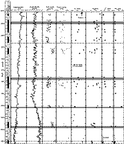  |
| Figure 6 (A, B). Summary of LWD data from Site 1045. Décollement zone (log Unit 7) in this region is characterized by a high-amplitude negative polarity seismic reflection. |
Traditional visual and multivariate statistical analyses of the logs define eight log units. Because Site 1045 was never cored, we inferred lithology from log properties and seismic correlation. Carbonate-rich and clay-rich lithologies apparently dominate the accretionary prism, with a substantial clay-rich interval for about 100 m above the décollement zone. Correlation of the logs to the seismic reflection data identifies an interval of extremely low density between 425 and 438 mbsf as the décollement zone.
Density and resistivity curves correlate positively, except below the décollement zone. These curves are inverted along two thrust faults that can be identified in the seismic reflection data and at several other depths in the logs where no structures are resolved seismically.
The density log places significant constraints on the hydrogeology of the accretionary prism, the décollement zone, and the underthrust sediments. A reversal of the consolidation trend in density occurs about 100 m above the top of the décollement zone. We believe that thrust imbrication of a low permeability clay-rich section has hindered consolidation. Extremely low densities down to 1.5 g/cm3 characterize the décollement zone. Sharp changes in density (~0.2 g/cm3) mark the top and bottom of the décollement zone. A comparison of the density profile through the proto décollement at Site 1044 and the décollement at Site 1045 shows that density lows at Site 1045 are higher, thinner, and more sharply defined than the broader low in the Site 1044 density data. Therefore the density distribution in the décollement can be explained by compaction of the proto décollement zone; dilation is not required. A synthetic seismogram based on the density log at Site 1045 reproduces the observed negative polarity reflection. Beneath the décollement zone, consolidation in the clay-rich upper part of the underthrust section is retarded, probably due to its low permeability and rapid loading by the overthrusting accretionary prism.
Site 1046
Site 1046 was drilled through the décollement zone of the northern Barbados accretionary prism 1.9 km west of the frontal thrust and about 900 m east of Site 1045 (Figs. 2, 3). Site 1046 is a re occupation of Site 949, a site that was partially cored and instrumented with a Circulation Obviation Retrofit Kit (CORK). The negative polarity reflection that characterizes the décollement beneath Site 1045 diminishes in strength during the lateral transition to Site 1046. At Site 1046, LWD acquired spectral gamma-ray, resistivity, density, caliper, photoelectric effect, and neutron porosity logs from the surface, through the décollement, and to the oceanic basement at 832 mbsf (Fig. 7A, 7B). All logs are of excellent quality except neutron porosity.
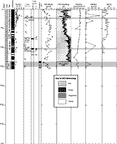 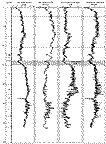 |
| Figure 7 (A, B). Summary of LWD data from Site 1046 compared to core data from Holes 959B and 949C. Shaded bars across diagram show fault zones identified in cores. |
Traditional visual and multivariate statistical analyses define eight log units. These log units subdivide into two sedimentary packages corresponding to the sections above and below the décollement zone. Sediments above the décollement are carbonate- and clay-rich calcareous claystone and noncalcareous claystone. Log Units 1-3a are dominated by the calcareous claystone. Falling resistivity in log Units 3a and 3b suggest a transition to a more clay-rich lithology above the décollement zone. A low-density interval in log Unit 4 and 5a correlates with the décollement zone. High gamma-ray and potassium values indicate significant terrigenous input in log Units 5b through 6b. The spiky resistivity response in log Unit 6 indicates cyclical sedimentation, probably turbidite deposition. The low resistivity and low gamma-ray values in log Unit 7 suggest pelagic sediment accumulation. Higher gamma-ray and resistivity values in log Unit 8 suggest correlation to the calcareous ferruginous unit cored at the base of Site 543.
Deformational features from cores and seismic data correlate well with log-inferred structural features. Inversions in the gamma-ray and density curves indicate thrust faults at 162, 225, 280, and 350 mbsf. Results from adjacent Site 949 confirm thrusting at 260, ~280, and 350 mbsf, but not at 162 mbsf because of discontinuous coring at that depth. Seismic data indicate a thrust fault at 282 mbsf that apparently correlates with the log-inferred thrust at 280 mbsf. The structurally defined décollement zone from the cores lies between 370 and 437 mbsf. A sharp drop in the density curve suggests that the top of the décollement zone is in log Unit 4 at 380 mbsf. The lower contact is indistinct but probably below 437 mbsf in a gradient of increasing density. Broad geochemical anomalies and a lack of thermal anomalies around the faults and décollement at Site 949 indicate fluid flow is not currently active along these structures. The synthetic seismogram reproduces the reflection at the thrust fault at ~280 m, but only weakly identifies the décollement.
The density log agrees well with all available core densities at Site 949, except those from the carbonate-rich zone at 300-322 mbsf. Comparisons of mean densities through the underthrust turbidite sequence at Site 1046 and an equivalent sequence at the reference Site 1044 suggest selective consolidation of this interval, assuming equivalent starting densities. Apparently fluids are being drained seaward through the high permeability turbidites. This hydrogeologic phenomenon also explains the high thermal gradient observed here at Site 949 and the reference Site 672.
Site 1047
Site 1047 was drilled 1 km west of the deformation front through the décollement zone and more than 300 m into the underthrust section of the northern Barbados accretionary prism (Figs. 2A, 2B, 3). Site 1047 is a re-occupation of Site 676, which was cored to 310 m and documented processes associated with initiation of sediment offscraping. At Site 1047, LWD tools acquired spectral gamma-ray, resistivity, density, caliper, photoelectric effect, and neutron porosity logs from the seafloor through the décollement and to ~300 m below it into the underthrust section (Fig. 8A, 8B). All logs are of excellent quality except neutron porosity.
  |
| Figure 8 (A, B). Summary of LWD data from Site 1047 and core data from Site 676. Log units for Hole 1047A can be compared to lithologic units of Site 676.Shaded bars across diagram show fault zones as identified in core and décollement zone as inferred from interval of low density (log Unit 3c). |
Traditional visual and multivariate statistical analyses define six log units (Fig. 8A, 8B). Log Unit 1 (0 158 mbsf) is characterized by increasing density with depth, a normal compaction trend, high resistivity, and high photoelectric effect. These log signatures are consistent with a carbonate-rich lithologic unit that occurs over the same depth interval at Site 676. Log Units 2, 3a, and 3b (158 276 mbsf) show a general decrease in resistivity, density, photoelectric effect, and gamma-ray values. These log responses reflect a downhole transition to an increasingly underconsolidated clay-rich unit above the décollement zone. An interval of very low density, low resistivity, and low gamma-ray values defines log Unit 3c (276-300 mbsf). This interval correlates to a lower Miocene radiolarian mudstone that includes mud-filled veins, a thrust fault, and a methane anomaly. This interval was interpreted as the incipient décollement zone at Site 676. An increase in differential caliper here and increased torque on the drill bit suggest that the muddy section was extruding into the drill hole, perhaps because of overpressuring. Log Units 4 (300-493 mbsf) and 5 (493-562 mbsf) exhibit a highly variable photoelectric effect and gamma-ray response, suggesting interbedded lithologies.
Resistivity data in Unit 5 indicate sand interbeds that are probably correlative to the turbidite sequence cored at Sites 671 and 672. Log Unit 6 (562-619 mbsf) is characterized by decreasing photoelectric effect and density, and increasing and variable gamma ray values. Log Unit 6 correlates with the early Eocene-aged noncalcareous claystones and siliceous claystones recovered at Sites 672 and 543.
Comparisons of the density curves from the reference Site 1044 and Site 1047 show selective consolidation in the décollement zone (log Unit 3) and the underthrust sandy turbidite section (log Unit 5). Presumably both intervals of localized consolidation are due to dewatering in response to localized deformation and loading due to underthrusting. A synthetic seismogram generated from the density log reproduces the negative polarity reflection from the décollement and the strong reflections from the underthrust turbidite sequence, but poorly matches reflections in the accretionary prism.
Site 1048
Site 1048 was drilled 2.1 km east of the deformation front into the sedimentary section coming into the northern Barbados accretionary prism and is 3.8 km west-southwest of co-located Sites 1044 and 672 (Figs. 2A, 2B, 3). At Site 1048, LWD acquired spectral gamma-ray, resistivity, density, caliper, photoelectric effect, and neutron porosity logs in a tectonically undisturbed oceanic section from the seafloor, through the proto- décollement, to a total depth of 324 mbsf (Fig. 9). All logs are of excellent quality except neutron porosity.
Traditional visual and multivariate statistical analyses define four log units whose lithology can be interpreted by correlation to Site 672. Log Unit 1 (0-105 mbsf) is characterized by increasing density, resistivity, and photoelectric effect with depth, and a normal compaction trend. These log signatures are consistent with a carbonate-rich lithologic unit that occurs from 0 to 123 mbsf at Site 672. Log Unit 2 (105-187 mbsf) shows a general decrease in resistivity, density, photoelectric effect, and gamma-ray values. Comparisons to Site 672 suggest that these log responses probably signify a downhole transition to an increasingly underconsolidated clay-rich unit. An interval of very low density, low resistivity, low photoelectric effect, and low gamma-ray values defines log Unit 3 (187-207 mbsf). This interval probably correlates to a lower Miocene radiolarian mudstone interpreted as the proto-décollement at Site 672. Log Unit 4 (207-324 mbsf) is characterized by increases in the density, gamma-ray, and photoelectric effect values. The highly variable (spikey) nature of the curves suggests interbedding of contrasting lithologies, and correlates with the muddy turbiditic unit beneath the décollement at Site 672.
Comparisons of the logs from the more seaward reference Site 1044 to Site 1048 show good correlation but a slightly thicker section at 1048. A synthetic seismogram generated from the density log reproduces well the shape and amplitude of the negative polarity reflection from the proto-décollement. The location of the proto- décollement occurs slightly higher in the upper reflective seismic unit than at Site 1044; thus, the basal surface of this seismic stratigraphic unit appears to be time transgressive. The most important result of Site 1048 is confirmation of the extremely low-density nature of the proto- décollement and the associated implications for localization of the detachment as the accretionary prism forms to the west.
Logging Scientists:
Saneatsu Saito
Candace Major, Lamont Doherty Earth Observatory
REFERENCES
Bangs, N.L., Shipley, T.H., and Moore, G.F., 1996. Elevated fluid pressure and fault zone dilation inferred from seismic models of the Northern Barbados Ridge décollement. J. Geophys. Res., 101:627-642.
Bangs, N.L., Westbrook, G.K., Ladd, J.W., and Buhl, P., 1990. Seismic velocities from the Barbados Ridge complex: Indicators of high pore fluid pressures in an accretionary complex. J. Geophys. Res., 95:8767-8782.
Bangs, N.L., and Westbrook, G.K., 1991. Seismic modeling of the décollement zone at the base of the Barbados Ridge accretionary complex. J. Geophys. Res., 96:3853-3866.
Bekins, B.A., McCaffrey, A.M., and Driess, S.J., 1995. Episodic and constant flow models for the origin of low-chloride waters in a modern accretionary complex. Water Resour. Res., 31:3205-3215.
Biju-Duval, B., Le Quellec, P., Mascle, A., Renard, V., and Valery, P., 1982. Multibeam bathymetric survey and high resolution seismic investigations of the Barbados Ridge complex (Eastern Caribbean): a key to the knowledge and interpretation of an accretionary wedge. Tectonophysics, 86:275-304.
Brown, K.M., and Behrmann, J., 1990. Genesis and evolution of small-scale structures in the toe of the Barbados Ridge accretionary wedge. In Moore, J.C., Mascle, A., et al., Proc. ODP Sci. Results, 110: College Station, TX(Ocean Drilling Program), 229-244.
Brown, K.M., Bekins, B.A., Clennell, B., Dewhurst, D., and Westbrook, G., 1994. Heterogeneous hydrofracture development and accretionary fault dynamics. Geology, 22:259-262.
Brückmann, W., Moran, K., and MacKillop, A.K., in press. Permeability and consolidation characteristics from Site 949B. In Shipley, T., Ogawa, Y., Blum, P., and Bahr, J. (Eds.), Proc. ODP, Sci. Results, 156: College Station, TX, (Ocean Drilling Program).
Dorel, J., 1981. Seismicity and seismic gap in the Lesser Antilles arc and earthquake hazard in Guadeloupe. Geophys. J. R. Astron. Soc., 67:679-695. Fisher, A.T., and Hounslow, M., 1990. Heat flow through the toe of the Barbados accretionary complex. In Moore, J.C., Mascle, A., et al., Proc. ODP, Sci. Results, 110: College Station, TX, (Ocean Drilling Program), 345-363.
Fisher, A.T., Zwart, G., and Shipboard Scientific Party, 1996. The relationship between permeability and effective stress along a plate-boundary fault, Barbados accretionary complex. Geology, 24:307-310.
Gieskes, J.M., Vrolijk, P., and Blanc, G., 1990. Hydrogeochemistry of the Northern Barbados Accretionary complex transect: Ocean Drilling Program Leg 110. J. Geophys. Res., 95:8809-8818.
Karig, D.E., 1986. Physical properties and mechanical state of accreted sediments in the Nankai Trough, S. W. Japan. In Moore, J.C. (Ed.), Structural Fabrics in Deep Sea Drilling Project Cores from Forearcs,. Mem. Geol. Soc. of Am., 66:117-133.
Kastner, M., in press. Geochemical synthesis. In Shipley, T., Ogawa, Y., Blum, P., Bahr, J. (Eds.), Proc. ODP, Sci. Results, 156: College Station, TX, (Ocean Drilling Program).
Labaume, P., and Kastner, M., in press. Vein formation in the Barbados accretionary prism. In Shipley, T., Ogawa, Y., Blum, P., and Bahr, J. (Eds.), Proc. ODP, Sci. Results, 156: College Station, TX, (Ocean Drilling Program).
Mascle, A., Moore, J.C., Taylor, E., et al., 1988. Proc. ODP, Init. Repts., 110: College Station, TX (Ocean Drilling Program).
Screaton, E.J., Fisher, A.T., Carson, B., and Becker, K., in press. Barbados Ridge hydrogeologic tests: Implications for fluid migration along an active décollement. Geology.
Shipley, T.H., Moore, G.F., Bangs, N., Moore, J.C., and Stoffa, P.L., 1994. Seismically inferred dilatancy distribution, northern Barbados Ridge décollement: implications for fluid migration and fault strength. Geology, 22:411-414.
Shipley, T., Ogawa, Y., Blum, P., et al., 1995. Proc. ODP, Init. Repts., 156: (Ocean Drilling Program), College Station, TX.
Shipley, T.H., Stoffa, P.L., and Dean, D.F., 1990. Underthrust sediments, fluid migration paths and mud volcanoes associated with the accretionary wedge off Costa Rica: Middle America Trench. J. Geophys. Res., 95:8743-8752.
Westbrook, G.K., Ladd, J.W., Buhl, P., Bangs, N., and Tilley, G.J., 1988. Cross section of an accretionary wedge: Barbados Ridge complex. Geology, 16:631-635.
Westbrook, G., Mascle, A., and Biju-Duval, B., 1984. Geophysics and structure of the Lesser Antilles forearc. In Biju-Duval, B., Moore, J.C., et al., Init. Repts. DSDP, 78A: Washington (U.S. Govt. Printing Office), 23-38.
Westbrook, G.K., and Smith, M.J., 1983. Long décollement and mud volcanoes: evidence from the Barbados Ridge Complex for the role of high pore-fluid pressure in the development of an accretionary complex. Geology, 11:279-283.
Zwart, G., Brückmann, W., Moran, K., MacKillop, A.K., Maltman, A.J., Bolton, A., Vrolijk, P., Miller, T., Gooch, M.J., and Fisher, A., in press. Evaluation of hydrogeologic properties of the Barbados accretionary prism: a synthesis of Leg 156 results. In Shipley, T., Ogawa, Y., Blum, P., and Bahr, J. (Eds.), Proc. ODP, Sci. Results, 156: College Station, TX, (Ocean Drilling Program).